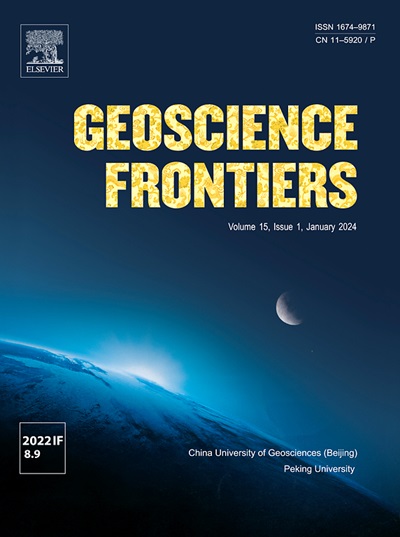弧后盆地俯冲起始的快照:来自藏西狮泉河蛇绿岩的启示
IF 8.9
1区 地球科学
Q1 GEOSCIENCES, MULTIDISCIPLINARY
引用次数: 0
摘要
弧后盆地是大洋岩石圈形成和汇聚板块边界消耗的关键场所,其形成和俯冲过程变化很大。西藏中部班公-怒江缝合带(BNSZ)内中特提斯石泉河-嘉里蛇绿岩亚带(SJO亚带)的构造背景和演化因其复杂的岩石组成和年代而备受争议。本文介绍了狮泉河蛇绿岩的年代学、地球化学和野外观测资料,并在SJO西端提供了一个具有代表性的蛇绿岩实例。通过对不同岩石类型的成因和构造背景的研究,结合U-Pb测年,提出了两期俯冲模型来解释SJO的构造演化和弧后盆地的消亡。地球化学和年代学资料表明,约183年马兰(拉米拉以北)辉长岩形成于弧前环境,代表了班公中特提斯早期的俯冲作用。这种俯冲作用诱发了约170 Ma的弧后扩张,记录在狮泉河蛇绿岩中PL-SDN (pagelizanon -Shiquanhe Dam Nan)蛇绿岩碎片的下枕玄武岩中。下玄武岩上覆的玄武岩熔岩,以约168 ~ 164 Ma辉绿岩脉和博宁岩脉为代表,具有弧前特征,代表了弧后盆地的晚期俯冲起始。从而恢复了SJO次带的多重构造演化,强调了弧后盆地俯冲在古海洋演化中的重要性。本文章由计算机程序翻译,如有差异,请以英文原文为准。

A snapshot of subduction initiation within a back-arc basin: Insights from Shiquanhe ophiolite, western Tibet
Back-arc basins are key sites for oceanic lithosphere formation and consumption at convergent plate boundaries, and their formation and subduction processes can be highly variable. The tectonic setting and evolution of the Meso-Tethys Shiquanhe-Jiali ophiolite sub-belt (SJO sub-belt) within Bangong-Nujiang Suture Zone (BNSZ), central Tibet, are disputed for the complex rock composition and ages. In this paper, we present geochronology, geochemistry and field observations on the Shiquanhe ophiolite, providing a representative ophiolite example in the western end of SJO. Based on investigation of the petrogenesis and tectonic setting of different rock types, combined with the U-Pb dating, we propose a two-stage subduction model for explaining the tectonic evolution of SJO as well as the wither away of a back-arc basin. Geochemical and geochronological data indicate that the ca. 183 Ma LAN (north of Lameila) gabbros formed in the forearc setting and represent the early-stage subduction of the Bangong Meso-Tethys. This subduction induced the back-arc spreading recorded in the ca. 170 Ma gabbros and lower pillow basalts of PL-SDN (Pagelizanong-Shiquanhe Dam Nan) ophiolitic fragments in the Shiquanhe ophiolite. The basaltic lavas overlying the lower basalts, represented by the ca. 168–164 Ma diabasic and boninite dikes have forearc characteristics, and they represent the back-arc basin subduction initiation at a late stage. This work thus recovered the multiple tectonic evolution of SJO sub-belt and emphasise the importance of the back-arc basin subduction in the evolution of ancient oceans.
求助全文
通过发布文献求助,成功后即可免费获取论文全文。
去求助
来源期刊

Geoscience frontiers
Earth and Planetary Sciences-General Earth and Planetary Sciences
CiteScore
17.80
自引率
3.40%
发文量
147
审稿时长
35 days
期刊介绍:
Geoscience Frontiers (GSF) is the Journal of China University of Geosciences (Beijing) and Peking University. It publishes peer-reviewed research articles and reviews in interdisciplinary fields of Earth and Planetary Sciences. GSF covers various research areas including petrology and geochemistry, lithospheric architecture and mantle dynamics, global tectonics, economic geology and fuel exploration, geophysics, stratigraphy and paleontology, environmental and engineering geology, astrogeology, and the nexus of resources-energy-emissions-climate under Sustainable Development Goals. The journal aims to bridge innovative, provocative, and challenging concepts and models in these fields, providing insights on correlations and evolution.
 求助内容:
求助内容: 应助结果提醒方式:
应助结果提醒方式:


